Military of the Warring States

The military of the Warring States refers primarily to the military apparatuses of the Seven Warring States which fought from around 475 BC to 221 BC when the state of Qin conquered the other six states, forming China's first imperial dynasty, the Qin dynasty.
Wu Qi (440-381 BC)

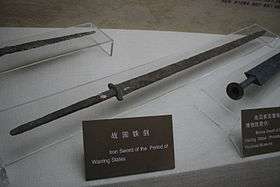
Wu Qi was a general born in the state of Wei who went on to serve in the state of Chu. He is traditionally credited with the authorship of the Wuzi, one of the Seven Military Classics, in which he described the military merits of six of the Warring States.
Qin
The nature of Qin's troops is to disperse so that each unit fights their own respective battles... The people of Qin are ferocious by nature and their terrain is treacherous. The government's decrees are strict and impartial. The rewards and punishments are clear. Qin soldiers are brave and high in morale so that they are able to scatter and engage in individual combat. To strike at Qin's army, we must entice various groups with small benefits; the greedy will abandon their general to give chase. We can then capitalize on this opportunity by hunting each group down individually and then capturing the generals that have been isolated. Finally, we must array our army to ambush their commander.
— Wuzi, Master Wu
- Soldiers sometime discarded armour in favor of fast charges
- According to Xun Qing (c. 314 – c. 217 BC), the people of Qin were "simple and unsophisticated", and their officials performed their tasks conscientiously without displaying partiality or forming cliques
- Almost complete absence of literati
Qi
Although Qi's military formations are dense, their organization is unstable...The people of Qi are by nature unyielding and their country prosperous, but the ruler and officials are arrogant and care nothing for the people. The state's policies are not uniform and not strictly enforced. Salaries and wages are unfair and unevenly distributed, causing disharmony and disunity. Qi's army is arrayed with their heaviest hitters at the front while the rest follow behind, so that even when their forces appear mighty, they are in reality fragile. To defeat them, we should divide our army into three columns and have two attack the left and right flanks of Qi's army. Once their battle formations are thrown into disarray, the central column should be in position to attack and victory will follow.
— Wuzi, Master Wu
Chu
Chu's military formations are complete but cannot be maintained for long... The Chu people are soft and weak. Their lands stretch far and wide, and the government cannot effectively administer the expanse. Their troops are weary and although their formations are well-ordered, they do not have the resources to maintain their positions for long. To defeat them, we must strike swiftly, unexpectedly and retreat quickly before they can counter attack. This will create unease in their weary soldiers and reduce their fighting spirit. Thus, with persistence, their army can be defeated.
— Wuzi, Master Wu
- Invented repeating crossbows
- Early adopter of iron and steel weapons
- Elite armoured crossbowmen capable of marching 160km "without resting"
Yan
Yan's defensive formations are solid but lack flexibility... The Yan are a sincere and straightforward people. They act prudently, love courage and esteem righteousness while rarely employing deception. Thus they excel in defensive positions, but are immobile and inflexible. To defeat them, immediately apply pressure with small attacks and retreat rapidly. When they turn to face our attacks, we should keep a distance. Attack the rear as well where and when they least expect it. When they withdraw to face another threat, chase them. This will confuse their generals and create anxiety in their ranks. If we avoid conflict against their strong points and use our armored chariots to set ambushes, we can capture their generals and insure victory.
— Wuzi, Master Wu
- Early adopter of iron and steel weapons
Han and Zhao
The two states of Han and Zhao train their troops rigorously but have difficulty in applying their skills to the battlefield... Han and Zhao are states of the Central Plain. Theirs are a gentle people, weary from war and experienced in arms, but have little regard for their generals. The soldiers' salaries are meager and their officers have no strong commitment to their countries. Although their troops are experienced, they cannot be expected to fight to the death. To defeat them, we must concentrate large numbers of troops in our attacks to present them with certain peril. When they counterattack, we must be prepared to defend our positions vigorously and make them pay dearly. When they retreat, we must pursue and give them no rest. This will grind them down.
— Wuzi, Master Wu
- Han made the best weapons
- Han was an early adopter of iron and steel weapons
- Han soldiers made use of face masks
- Zhao was an early adopter of mounted archers
Wei
Wu Qi did not mention the military merits of Wei.
- Elite armoured soldiers capable of marching 40km with a crossbow, sword, and 50 bolts
Other states
Lu
- Earliest archaeological evidence of crossbows
Shang Yang Reforms

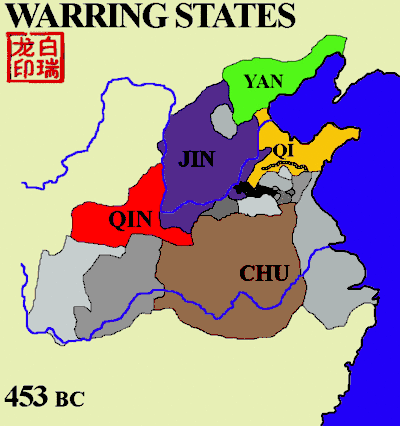
The rapid growth of Qin's military began with the adoption of Shang Yang's Legalist reforms beginning in 361 BC. Shang Yang was originally a minor official in the state of Wei, but failed to gain recognition there and defected to Qin in 361 BC. Shang Yang personally led the Qin army to wage war on his native homeland and recovered territory previously lost to Wei. This forced Wei to shift its capital eastward to Daliang in 340 BC. Unfortunately after the death of Duke Xiao of Qin in 338 BC, Shang Yang was accused of treason and killed.[1]
Shang Yang's reforms encompassed a broad ranging overhaul of Qin society which centralized political power and geared society towards greater agricultural efficiency and mass military conscription.[2]
Lord Shang’s overall aim was to mobilize the state for warfare. He saw the great mass of commoners as a resource of the state to further its military objectives; common people were to devote themselves to agriculture to support the army and were also subject to military conscription and corvée labor. They were to be kept ignorant, docile, and obedient, and were kept in line by a code of laws that provided ferocious punishments for all infractions (such as mutilation or being torn apart limb by limb). Household registration was also a form of control. Households were registered in groups of five; each was responsible for the others. If a crime occurred and was not reported by the miscreant’s neighbors in their household group, all five would be subject to punishment along with the actual criminal. Explicit regulations also governed the conduct of government officials, who could be punished both for failing to carry out their stated responsibilities and for encroaching on the duties of others. In general the civilian government was subordinated to the armed forces and the chief means of advancement in rank was prowess on the battlefield, measured by the number of enemy heads taken. In the end Shang Yang overreached himself and, by amassing too much power, incurred the jealousy of others. After the death of Lord Xiao, Shang Yang was accused of treason and executed by being tied to two chariots and torn apart. But his reforms endured, launching Qin on a century-long drive for power and continuing to form the basis of Chinese law during the imperial age.[3]
— John S. Major
Politics
In 350 BC, Shang Yang reorganized Qin into 31 counties, each administered by a centrally appointed magistrate.[4]
Agriculture
Shang Yang reduced the power of hereditary landholders by replacing labor services with taxation. The well field system under which peasants cultivated plots of land for their overlords was abolished. Peasants were given the right to sell and buy farmland to entice resettlement from neighboring populations.[5]
Law
Pillars were erected at the capital to promulgate new laws, which emphasized that "The punishments did not spare the strong and great" and meritorious service would be rewarded.[6]
Group responsibility
The population was divided into units of five or ten families, within which all members were responsible for each others' actions.
Whoever did not denounce a culprit would be cut in two; whoever denounced a culprit would receive the same reward as he who decapitated an enemy; whoever concealed a culprit would receive the same punishment as he who surrendered to an enemy[6]
Shang Yang also sought to weaken family solidarity by applying double taxes to households with more two or more adult males living together. In 350 BC he outright forbade fathers and adults sons or brothers from cohabiting with one another.[7]
Ranks
Shang Yang created a system of eighteen ranks, each gained through slaying one enemy, which conferred benefits such as tax and labor exemptions or land and office. However later in 243 BC, ranks could also be gained by contributing grain to the government.[7]
Standardization
Weights and measures were standardized to facilitate governance.[8]
Military ideology
From antiquity to the present time, it has never happened that one attained supremacy without conquest, or that one came to ruin without defeat. If the people are brave, one conquers in war, but if they are not brave, one is defeated in war. If one can unify the people for war, they are brave, but if one cannot unify the people for war, they are not brave. A sage-king obtains the kingship through the efforts of his soldiers. Therefore, he rouses the country and charges it with the obligation of military service. If one enters a state and sees its administration, it is strong if its people are of use. How does one know that the people are of use? If they, on perceiving war, behave like hungry wolves on seeing meat, then they are of use. Generally, war is a thing that people hate; he who succeeds in making people delight in war attains supremacy.[9]
Formations
In general, there are ten formations: square (fang 方), round (yuan 圓), dispersed (shu 疏), dense (shu 數), awl (zhui hang 錐行), geese (yan hang 雁行), hook (gou hang 鉤行), dark wings (xuanyi 玄翼), fire (huo 火), and water (shui 水). These all have their particular advantages. The square formation is for cutting through the enemy. The round formation is for concentrating the enemy. The dispersed formation is for . . . [undeciphered text]. The dense formation is for preventing enemy penetrations. The awl formation is for penetrating enemy lines. The geese formation is for closing with the enemy with bow and arrow. The hook formation is for making rapid changes in battle plans. The dark wings formation is for placing the enemy in doubt and encumbering the enemy’s resoluteness. The fire formation is for seizing the enemy [by means of fire or extracting oneself from enemy attack by fire]. And the water formation is for disrupting the enemy [when attacking by water or defending against enemy attacks by water].[10]
Sun Bin advised deploying long weapons on the front lines, short weapons behind, and with support from archers.[11] Square formations were suited to level ground, round formations to rugged ground, pointed formation when facing higher ground, and a square formation with wings when enveloping a battle line.[12] Sun Bin also provides a general guideline for some formations to follow[13]:
- Square formations should be sparse in the center, thick at the sides, and especially strong in the back.
- Dispersed formations are for when there is little armour and manpower, so that a formation appears strong and firm. By setting up banners, flags, sharpened weapons at the edges, and arraying numerous small groups to advance and retreat, one can initimidate the enemy.
- Dense formations should have troops travelling in close quarters with enough room to wield weapons properly and not injure each other. It should be tightly woven and contain no gaps.
- Awl formations should be thick at the base and sharp at the edges.
- Hook formations should have a front line that is straight with wings that are curved.
- Dark wing formations must be well ordered and use many flags and insignia, so that when they all move at once, the foot soldiers cause an immense racket.
Chariot
.jpg)
Warfare during the earlier period was dominated by chariot-riding aristocrats who fought one another according to rules of chivalry and for whom prestige and “face” meant more than practical gain. The later wars were dominated by professional generals who fought grimly to acquire territory and resources for whatever state employed them. The role of war chariots (always hard to maneuver in irregular terrain) diminished greatly, while that of massed infantry correspondingly increased. From the horseback-riding pastoral peoples of Inner Asia, the Chinese learned, at the end of the fourth century (specifically in the state of Zhao in 307), how to use mounted archers as an important supplement to infantry.[14]
— Derk Bodde
Armour
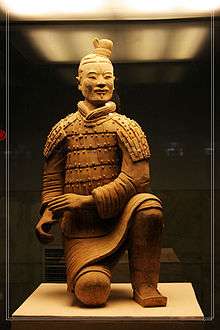
In the 4th century BC, rhinoceros armour was still used. In the following passage Guan Zhong advises Duke Huan of Qi to convert punishments to armour and weapons:
Ordain that serious crimes are to be redeemed with a suit of rhinoceros armour and one halberd, and minor crimes with a plaited leather shield and one halberd. Misdemeanours are to be punished with [a fine of] a quota of metal [jin fen 金分], and doubtful cases are to be pardoned. A case should be delayed for investigation for three [days] without allowing arguments or judgements; [by the time] the case is judged [the subject will have produced] one bundle of arrows. Good metal [mei jin 美金] should be cast into swords and halberd[-heads] and tested on dogs and horses, while poorer metal [e jin 惡金] should be cast into agricultural implements and tested on earth.[15]
— Guan Zhong
Ferrous metallurgy
However by the mid-4th century BC, lamellar armour of leather, bronze, and iron appeared. Lamellar consisted of individual armour pieces that were either riveted or laced together to form a suit of armour.[16]
In the 3rd century BC, both iron weapons and armour became more common. According to the Xunzi, "the hard iron spears of Wan 宛 [a city in Chu, near modern Nanyang 南陽, Henan] are as cruel as wasps and scorpions."[17] Iron weapons also gave Chinese armies an edge over barbarians. Han Fei recounts that during a battle with the Gonggong 共工 tribe, "the iron-tipped lances reached the enemy, and those without strong helmets and armour were injured."[18] As a result of the increasing effectiveness of iron weapons and armour, shields and axes became less common.[19] The efficiency of crossbows however outpaced any progress in defensive armour. It was considered a common occurrence in ancient China for commoners or peasants to kill a lord with a well aimed crossbow bolt, regardless of whatever armour he might have been wearing at the time.[20]
Shun taught the ways of good government for the following three years, and then took up shield and battle-ax and performed the war dance, and the Miao submitted. But in the war with the Gonggong, men used iron lances with steel heads that reached to the enemy, so that unless one was protected by a stout helmet and armor he was likely to be wounded. Hence shields and battle-axes served for ancient times, but no longer serve today. So I say that as circumstances change the ways of dealing with them alter too.[21]
— Han Fei
Armour was mostly restricted to elite guard units and each state distributed armour in their own ways. The state of Chu favorited elite armoured crossbow units known for their endurance, and were capable of marching 160km 'without resting.'[16] Wei's elite forces were capable of marching over 40km in one day while wearing heavy armour, a large crossbow with 50 bolts, a helmet, a side sword, and three days worth of rations. Those who met these standards earned an exemption from corvée labor and taxes for their entire family.[22]
According to Su Qin, the state of Han made the best weapons, capable of cleaving through the strongest armour, shields, leather boots and helmets.[23] Their soldiers wore iron facemasks.[16]
The Qin calculated fines in terms of one or two coats of armour, lower crimes in terms of shields, and the lowest in terms of coins.[24] Qin soldiers sometimes threw off their armour and engaged in fast charges.[25]
By the end of the 3rd century BC at least a few horsemen wore armour of some kind.[16]
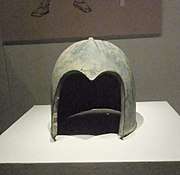 Warring States bronze helmet
Warring States bronze helmet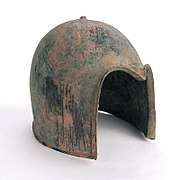 Warring States helmet
Warring States helmet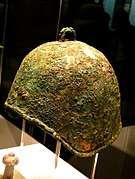 Warring States helmet
Warring States helmet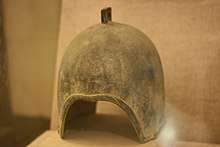 Warring States helmet
Warring States helmet Warring States rectangular shield (91.8cm tall, 49.6cm wide)
Warring States rectangular shield (91.8cm tall, 49.6cm wide)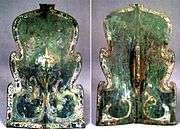 Qin shield (35.6cm tall, 23.5cm wide, 0.4cm thick)
Qin shield (35.6cm tall, 23.5cm wide, 0.4cm thick)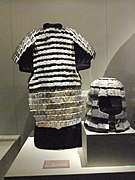 Qin stone armour
Qin stone armour
Swords and polearms

Iron and steel swords of 80 to 100 cm in length appeared during the mid Warring States period in the states of Chu, Han, and Yan. The majority of weapons were still made of bronze but iron and steel weapons were starting to become more common.[26] By the end of the 3rd century BC, the Chinese had learned how to produce quench-hardened steel swords, and bronze weapons went out of use completely.[27]
By the end of the 4th century BC, dagger-axes with spearheads began to appear, essentially becoming a halberd. Spears and halberds came in two general sizes. One about 2.8 m long and the other around 5.5m, or what would be considered a pike in western terminology.[28] According to Wu Qi, tall men were given bows and arrows while short men spears and halberds.[29]
The Zhan Guo Ce states that the state of Han made the best weapons, capable of cleaving through the strongest armour, shields, leather boots and helmets.[23]
Sword dances are mentioned shortly after the end of the Qin dynasty.[30] Swords up to 110 cm in length began to appear.[31]
- Warring States bronze jians
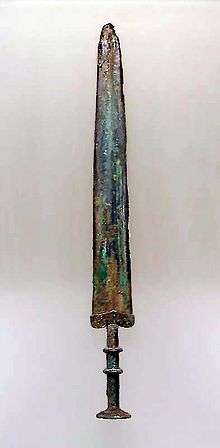 Warring States bronze jian
Warring States bronze jian Chu iron jian
Chu iron jian Qin bronze jians
Qin bronze jians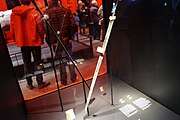 Qin jian
Qin jian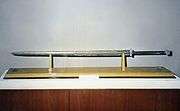 Qin jian
Qin jian
Crossbow
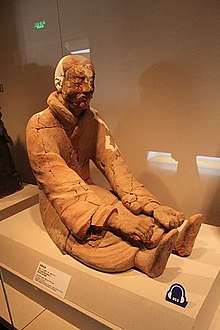
In terms of archaeological evidence, crossbow locks made of cast bronze have been found in China dating to around 650 BC.[32] They have also been found found in Tombs 3 and 12 at Qufu, Shandong, previously the capital of Lu, and date to 6th century BC.[33][34] Bronze crossbow bolts dating from the mid-5th century BC have been found at a Chu burial site in Yutaishan, Jiangling County, Hubei Province.[35] Other early finds of crossbows were discovered in Tomb 138 at Saobatang, Hunan Province, and date to mid-4th century BC.[36][37] It's possible that these early crossbows used spherical pellets for ammunition. A Western-Han mathematician and music theorist, Jing Fang (78-37 BC), compared the moon to the shape of a round crossbow bullet.[38] Zhuangzi also mentions crossbow bullets.[39]
The earliest Chinese documents mentioning a crossbow were texts from the 4th to 3rd centuries BC attributed to the followers of Mozi. This source refers to the use of a giant crossbow between the 6th and 5th centuries BC, corresponding to the late Spring and Autumn Period. Sun Tzu's The Art of War (first appearance dated between 500 BC to 300 BC[40]) refers to the characteristics and use of crossbows in chapters 5 and 12 respectively,[41] and compares a drawn crossbow to 'might.'[42]
The state of Chu favorited elite armoured crossbow units known for their endurance, and were capable of marching 160km 'without resting.'[16] Wei's elite forces were capable of marching over 40km in one day while wearing heavy armour, a large crossbow with 50 bolts, a helmet, a side sword, and three days worth of rations. Those who met these standards earned an exemption from corvée labor and taxes for their entire family.[22]
Repeating crossbow
The Zhuge Nu is a handy little weapon that even the Confucian scholar or palace women can use in self-defence... It fires weakly so you have to tip the darts with poison. Once the darts are tipped with "tiger-killing poison", you can shoot it at a horse or a man and as long as you draw blood, your adversary will die immediately. The draw-back to the weapon is its very limited range.[32]
According to the Wu-Yue Chunqiu (history of the Wu-Yue War), written in the Eastern Han dynasty, the repeating crossbow was invented during the Warring States Period by a Mr. Qin from the State of Chu. This is corroborated by the earliest archaeological evidence of repeating crossbows, which was excavated from a Chu burial site at Tomb 47 at Qinjiazui, Hubei Province, and has been dated to the 4th century BC, during the Warring States Period (475 - 220 BC).[43] Unlike repeating crossbows of later eras, the ancient double shot repeating crossbow uses a pistol grip and a rear pulling mechanism for arming. The Ming repeating crossbow uses an arming mechanism which requires its user to push a rear lever upwards and downwards back and forth.[44] Although hand held repeating crossbows were generally weak and required additional poison, probably aconite, for lethality, much larger mounted versions appeared during the Ming dynasty.[32]
The invention of the repeating crossbow has often been attributed to Zhuge Liang but he in fact had nothing to do with it. This misconception is based on a record attributing improvements to the multiple bolt crossbows to him.[45]
Mounted crossbow
Large mounted crossbows known as "bed crossbows" were used as early as the Warring States period. Mozi described them as defensive weapons placed on top the battlements. The Mohist siege crossbow was described as humongous device with frameworks taller than a man and shooting arrows with cords attached so that they could be pulled back. By the Han dynasty, crossbows were used as mobile field artillery and known as "Military Strong Carts".[46] Around the 5th century AD, multiple bows were combined together to increase draw weight and length, thus creating the double and triple bow crossbows. Tang versions of this weapon are stated to have obtained a range of 1,160 yards, which is supported by Ata-Malik Juvayni on the use of similar weapons by the Mongols in 1256.[47]
Multiple bolt crossbow
The multiple bolt crossbow appeared around the late 4th century BC. A passage dated to 320 BC states that it was mounted on a three wheeled carriage and stationed on the ramparts. The crossbow was drawn using a treadle and shot 10 foot long arrows. Other drawing mechanisms such as winches and oxen were also used.[48] Later on pedal release triggers were also used.[49] Although this weapon was able to discharge multiple bolts, it was at the cost of reduced accuracy since the further the arrow was from the center of the bow string, the more off center its trajectory would be.[46] It had a maximum range of 500 yards.[50]
When Qin Shi Huang's magicians failed to get in touch with "spirits and immortals of the marvellous islands of the Eastern Sea", they excused themselves by saying large monsters blocked their way. Qin Shi Huang personally went out with a multiple bolt crossbow to see these monsters for himself. He found no monsters but killed a big fish.[51]
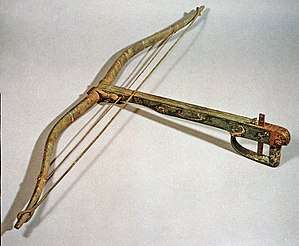 Qin dynasty crossbow.
Qin dynasty crossbow.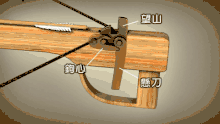 A Chinese crossbow shooting mechanism.
A Chinese crossbow shooting mechanism. The earliest extant repeating crossbow, a double-shot repeating crossbow excavated from a tomb of the State of Chu, 4th century BC.
The earliest extant repeating crossbow, a double-shot repeating crossbow excavated from a tomb of the State of Chu, 4th century BC.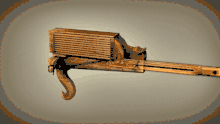 Double shot repeating crossbow, also known as the Chu state repeating crossbow (chuguo nu)
Double shot repeating crossbow, also known as the Chu state repeating crossbow (chuguo nu)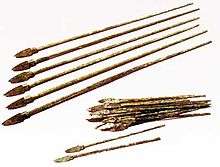 Large and small Qin crossbow bolts
Large and small Qin crossbow bolts A modern multiple shot crossbow
A modern multiple shot crossbow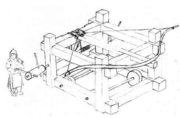 Modern interpretation of the large crossbow described by Mozi
Modern interpretation of the large crossbow described by Mozi
Siege equipment
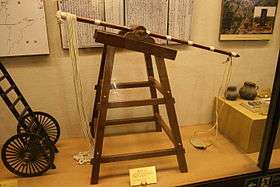
Warring States siege equipment consisted of siege ladders, siege towers, and the traction trebuchet.[52] The traction trebuchet, also referred to as a mangonel in some sources, is an artillery weapon which derives from manpower its motive force, and was probably used by the Mohists starting from the 4th century BC. Descriptions of it can be found in the Mojing (compiled in the 4th century BC). It consisted of an arm and sling mounted on a wooden frame, sometimes with wheels. Attached to one end of the arm were pulling ropes for men to power the weapon.[53] Trebuchets mounted on wheels were said to have needed 200 men to pull each of them.[54] In Chapter 14 of the Mojing, the traction trebuchet is described hurling hollowed out logs filled with burning charcoal at enemy troops.[46] Mobile siege towers have been used in China since the 6th century BC. They were often called overlook carts, assault carts, or some combination of the two.[46] A typical mobile siege tower was five stories tall mounted on axles with two wheels on each side. The tower was pushed forward by men on the lowest storey or pulled by horses and oxen.[55]
The king of Wu mentioned it in a passage comparing land armies to the navy.
These days in training we use the (same) tactics of land armies for the best effect. Thus big wing ships correspond to the army's heavy chariots, small wing ships to their light chariots, stomach strikers to battering rams, castled ships to mobile assault towers and bridge ships to the light cavalry.[46]
— King of Wu (514 - 496 BC)
Army sizes
.jpg)
The army sizes given by the Records of the Grand Historian for the Warring States are almost certainly highly inflated. At several points it gives army figures upwards of several hundred thousand for both Qin and its enemies, each of which would be larger than the entire army mobilized by the Han dynasty at its height, which ranged from around 130,000 to 300,000 under Emperor Wu of Han.[56]
Sun Tzu, for example, calculates the cost of provisions, equipment and other expenses for an expedition of 100,000 men at a fairly precise 1,000 pieces of money per day. On the other hand it seems to have been customary to state any large number in units of ten or a hundred thousand, and the chroniclers were probably in the habit of using these figures to denote units of approximately that nominal strength. One entry in the Official History of the Han dynasty implies as much when it states that the men collected for one campaign against the Hsiung-nu numbered more than 40,000, ‘and were called a hundred thousand’. This may have been done simply for administrative convenience or to denote the appropriate level of command, in the same way as we might refer to a brigade or a division, regardless of whether or not it is actually at full strength. The corrupt practice of commanders inflating the numbers on the rolls in order to siphon off surplus pay and rations, which is known to have been a major problem under later dynasties, may also have been a factor. It may be best to consider the figures given in narrative sources as useful for relative strengths but not for absolute ones, or if we insist of hazarding a guess at the latter, the ratio of forty to a hundred indicated in the passage quoted above may be at least a rough guide.[57]
— Chris Peers
Citations
- ↑ Twitchett 2008, p. 34.
- ↑ Twitchett 2008, p. 34-35.
- ↑ Major 2017, p. 150.
- ↑ Twitchett 2008, p. 35.
- ↑ Twitchett 2008, p. 35-36.
- 1 2 Twitchett 2008, p. 36.
- 1 2 Twitchett 2008, p. 37.
- ↑ Twitchett 2008, p. 38.
- ↑ Rand 2017, p. 23.
- ↑ Rand 2017, p. 65-66.
- ↑ Sun 2000, p. 336.
- ↑ Sun 2000, p. 370.
- ↑ Sun 2000, p. 378-379.
- ↑ Twitchett 2008, p. 24-25.
- ↑ Wagner 2008, p. 85.
- 1 2 3 4 5 Peers 2006, p. 39.
- ↑ Wagner 2008, p. 116.
- ↑ Wagner 2008, p. 117.
- ↑ Wager 2008, p. 117.
- ↑ Robinson 2004, p. 10.
- ↑ Han 2003, p. 101.
- 1 2 Lewis 2007, p. 38.
- 1 2 Peers 2013, p. 60.
- ↑ Twitchett 2008, p. 50.
- ↑ Peers 2006, p. 41.
- ↑ Lorge 2011, p. 37.
- ↑ Wagner 1996, p. 197.
- ↑ Peers 2006, p. 32.
- ↑ Peers 2006, p. 31.
- ↑ Lorge 2011, p. 62.
- ↑ Peers 2006, p. 44.
- 1 2 3 Loades 2018.
- ↑ You (1994), 80.
- ↑ A Crossbow Mechanism with Some Unique Features from Shandong, China. Asian Traditional Archery Research Network. Retrieved on 2008-08-20.
- ↑ Wagner, Donald B. (1993). Iron and Steel in Ancient China: Second Impression, With Corrections. Leiden: E.J. Brill. ISBN 90-04-09632-9. pp. 153, 157–158.
- ↑ Mao (1998), 109–110.
- ↑ Wright (2001), 159.
- ↑ Needham, Joseph (1986). Science and Civilization in China: Volume 3, Mathematics and the Sciences of the Heavens and the Earth. Taipei: Caves Books Ltd, p. 227.
- ↑ Needham 1994, p. 89.
- ↑ James Clavell, The Art of War, prelude
- ↑ https://www.gutenberg.org/files/132/132.txt
- ↑ Needham 1994, p. 34.
- ↑ Lin, Yun. "History of the Crossbow," in Chinese Classics & Culture, 1993, No.4: p. 33–37.
- ↑ Unique weapon of the Ming Dynasty — Zhu Ge Nu (諸葛弩), retrieved 16 April 2018
- ↑ Needham 1994, p. 8.
- 1 2 3 4 5 Liang 2006.
- ↑ Turnbull 2002, p. 14.
- ↑ Needham 1994, p. 189-190.
- ↑ Needham 1994, p. 192.
- ↑ Needham 1994, p. 176.
- ↑ Needham 1994, p. 188.
- ↑ Turnbull 2002, p. 40.
- ↑ Turnbull 2001, p. 18.
- ↑ Turnbull 2001, p. 18-19.
- ↑ Needham 1994, p. 439.
- ↑ Twitchett 2008, p. 99.
- ↑ Peers 2013, p. 55.
References
- Andrade, Tonio (2016), The Gunpowder Age: China, Military Innovation, and the Rise of the West in World History, Princeton University Press, ISBN 978-0-691-13597-7 .
- Coyet, Frederic (1975), Neglected Formosa: a translation from the Dutch of Frederic Coyett's Verwaerloosde Formosa
- Crespigny, Rafe de (2017), Fire Over Luoyang: A History of the Later Han Dynasty, 23-220 AD, Brill
- Graff, David A. (2002), Medieval Chinese Warfare, 300-900, Routledge
- Graff, David A. (2016), The Eurasian Way of War: Military practice in seventh-century China and Byzantium, Routledge
- Han, Fei (2003), Han Feizi: Basic Writings, Columbia University Press
- Jackson, Peter (2005), The Mongols and the West, Pearson Education Limited
- Kurz, Johannes L. (2011), China's Southern Tang Dynasty, 937-976, Routledge
- Lewis, Mark Edward (2007), The Early Chinese Empires: Qin and Han, The Belknap Press of Harvard University Press
- Liang, Jieming (2006), Chinese Siege Warfare: Mechanical Artillery & Siege Weapons of Antiquity, Singapore, Republic of Singapore: Leong Kit Meng, ISBN 981-05-5380-3
- Loades, Mike (2018), The Crossbow, Osprey
- Lorge, Peter (2015), The Reunification of China: Peace through War under the Song Dynasty, Cambridge University Press
- Major, John S. (2017), Ancient China: A History, Routledge
- Mesny, William (1896), Mesny's Chinese Miscellany
- Needham, Joseph (1994), Science and Civilization in China Volume 5 Part 6, Cambridge University Press
- Peers, C.J. (2006), Soldiers of the Dragon: Chinese Armies 1500 BC - AD 1840, Osprey Publishing Ltd
- Peers, Chris (2013), Battles of Ancient China, Pen & Sword Military
- Perdue, Peter C. (2005), China Marches West, The Belknap Press of Harvard University Press
- Rand, Christopher C. (2017), Military Thought in Early China, SUNY Press
- Robinson, K.G. (2004), Science and Civilization in China Volume 7 Part 2: General Conclusions and Reflections, Cambridge University Press
- Sun, Tzu (2000), The Art of War: Complete Texts and Commentaries, Shambhala
- Swope, Kenneth M. (2009), A Dragon's Head and a Serpent's Tail: Ming China and the First Great East Asian War, 1592–1598, University of Oklahoma Press
- Turnbull, Stephen (2001), Siege Weapons of the Far East (1) AD 612-1300, Osprey Publishing
- Turnbull, Stephen (2002), Siege Weapons of the Far East (2) AD 960-1644, Osprey Publishing
- Twitchett, Denis (2008), The Cambridge History of China: Volume 1, Cambridge University Press
- Wood, W. W. (1830), Sketches of China
- Wagner, Donald B. (1996), Iron and Steel in Ancient China, E.J. Brill
- Wagner, Donald B. (2008), Science and Civilization in China Volume 5-11: Ferrous Metallurgy, Cambridge University Press
- Wright, David (2005), From War to Diplomatic Parity in Eleventh Century China, Brill
- Ancient Chinese Armies: 1500-200BC C.J. Peers, Illustrated by Angus McBridge, Osprey Publishing «Men-at-arms», ISBN 0-85045-942-7
- Imperial Chinese Armies (1): 200BC-AD589 C.J. Peers, Illustrated by Michael Perry, Osprey Publishing «Men-at-arms», ISBN 1-85532-514-4
- Imperial Chinese Armies (2): 590-1260AD C.J. Peers, Illustrated by Michael Perry, Osprey Publishing «Men-at-arms», ISBN 1-85532-599-3
- Medieval Chinese Armies: 1260-1520 C.J. Peers, Illustrated by David Sque, Osprey Publishing «Men-at-arms», ISBN 1-85532-254-4
- Late Imperial Chinese Armies: 1520-1840 C.J. Peers, Illustrated by Christa Hook, Osprey Publishing «Men-at-arms», ISBN 1-85532-655-8